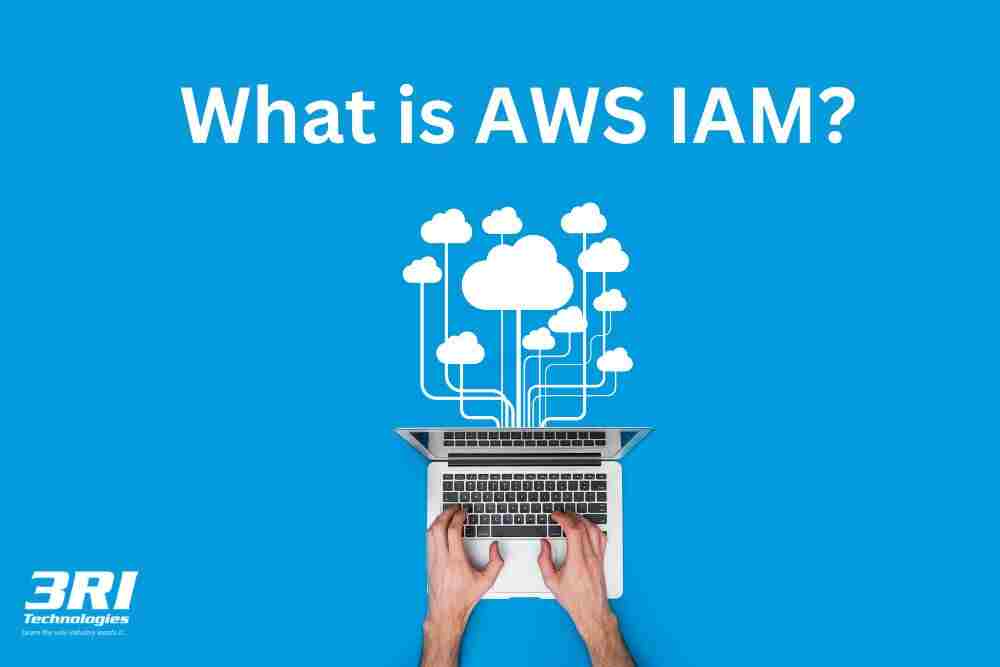AWS IAM (Identity and Access Management) is a web service provided by Amazon Web Services (AWS) that enables the user to manage users and their access to the AWS infrastructure. It allows for the creation of users, groups, and roles, and the assignment of permissions to those entities. IAM also provides features such as multi-factor authentication and access keys for programmatic access to AWS services. This enables users to create and manage secure access to their AWS resources.
Many developers and IT professionals beginning their journey with Amazon Web Services often ask, “what is AWS IAM?” or want to understand “what is IAM in AWS.” This foundational service, Amazon IAM (Identity and Access Management), is paramount for securing your cloud resources. It allows you to control who is authenticated (signed in) and authorized (has permissions) to use resources. In this article, we’ll clearly define what is AWS IAM, explore essential concepts like what is an IAM user in AWS, and illustrate how it helps you maintain robust security. To truly master these principles and effectively implement IAM strategies, consider enhancing your skills through dedicated learning; our AWS Online Certification Training provides comprehensive knowledge and practical expertise.
Defining AWS IAM: What is IAM in AWS Fundamentally?
Cloud security is a significant priority at AWS. When you host your cloud environment somewhere, you can be certain that it is housed in a data center or network architecture that meets the requirements of even the most security-conscious company. Moreover, pay-as-you-go availability of this high level of protection means that there is essentially no upfront cost and the service is significantly less expensive than in an on-premises scenario.
AWS employs a select few security services—IAM, Web Access Firewall (WAF), Cognito, and Key Management System (KMS)—to a large extent despite the wide range of options available.
IAM IN AWS
AWS IAM (Identity and Access Management) is a web service provided by Amazon Web Services (AWS) that enables the user to manage users and their access to the AWS infrastructure. With IAM, you can establish and manage AWS groups and users as well as control who has access to AWS resources. Your AWS account has an element called IAM that is provided free of charge. IAM can be used to restrict your users’ access to AWS resources and services.
IAM enables you to:
- Create and manage AWS users and groups
- Securely manage user access to AWS resources
- Restrict user access to AWS services and resources
- Use multi-factor authentication (MFA) for additional security
- Create and manage access keys for programmatic access to AWS resources
- Establish your own password policy for your users to follow.
AWS Identity and Access Management (IAM) is an AWS service that helps an administrator securely control access to AWS resources for the users and roles within their AWS account. With IAM, you can create and manage AWS users, groups and roles, and use permissions to allow and deny their access to AWS resources.
Interested to begin a career in AWS? Enroll now for AWS Training in Pune.
How IAM Works?
The six components of the IAM workflow are as follows:
1. An entity with the ability to operate on an AWS resource is called a principal. A principal might be an application, a role, or a user.
2. Verifying the identity of the principal attempting to access an AWS service is an aspect of authentication. In order to authenticate, the principal must supply its credentials or necessary keys.
3. A principal notifies AWS of the activity and the resource that is to be carried out in a request.
4. All resources are blocked by default. A request is only authorized by IAM if every component of the request is permitted by a matching policy. AWS authorizes and authenticates the request before approving the activity.
5. A resource can be viewed, created, edited, or deleted using actions.
6. You can carry out a series of operations on an AWS account-related resource.
What Does IAM Do?
Utilizing IAM, we carry out the following
Identities within IAM
Using IAM Identities, we can assign rules to users, groups, and roles in the AWS Console, allowing us to manage which users have access to which resources and services. The Root user can be used to generate IAM Identities.
IAM Users Classified as
1. IAM Users
2. IAM Groups
3. IAM Roles
Root user
Unrestricted rights will be automatically granted to the root user. To have complete control over the Amazon account, we can create an admin user with less authority.
IAM Users
If we can remember their login credentials, we can use IAM users to access the AWS Console. Their administrative permissions are different from the Root user’s.
As an illustration
We can achieve our objective of granting a specific individual access to all services offered in the Amazon dashboard with a restricted set of permissions, like read-only access, with the help of IAM users.
IAM Groups
A group is an assembly of users, and an individual may belong to multiple groups. We can swiftly and effectively manage permissions for numerous users with the help of groups.
As an illustration
We can add a newly added user with the required permissions to the required group.
IAM Roles
IAM roles and IAM users are similar in that anyone who needs them can assume them, even though policies cannot be directly granted to any of the services that are accessible through the Amazon dashboard. We can grant other AWS Services access rights by utilizing roles.
As an illustration
First, we need to create a role, then we need to attach the required policies to that role, and finally we need to attach that specific role to EKS.
IAM Policies
IAM Policies can be connected to resources or IAM Identities in order to control access for AWS. When a user or resource submits a request to AWS, these policies are validated by AWS, which then determines whether to approve or deny the request. IAM policies define the permissions of AWS identities and resources.
Components of IAM
The four main aspects of IAM are authentication, authorization, administration, auditing, and reporting.
1. Authentication
This procedure actively verifies the identity of users or employees by requesting each user’s unique identification number and the necessary credentials to support their identity. Examples of this include passwords, emails, usernames, biometrics (facial or fingerprint recognition), and electronic access (swipe cards, smartcards, RFID, etc.). Certificates and multifactor authentication (MFA) are two possible authentication sources.
2. Authorization
This is the procedure for giving people access to resources and tools.User A’s access is actively distinguished from User B’s by the authorization framework. This framework controls access based on role in the IAM system; it is also referred to as AuthZ.
3. Administration
The administration serves as the foundation for all other frameworks. Authentication and authorization are made possible by this subsystem. The cornerstone is the administration of various departments, groups, and users. Upon successful authentication, users are granted access to various tools and resources. Group permissions and user accounts are managed by administration. Without authentication, users are unable to access the entire system; however, authorization maintains the rights given to these groups and individuals.
4. Auditing and Reporting (A&R)
Examining, documenting, and appropriately reporting user access logs and all security-related system activity are all part of the auditing and reporting component. This maintains the security of the system and encourages continued adherence to the rules that must govern the company. Different industries have different laws and regulations to abide by; many require ongoing reporting and auditing to safeguard user data. This covers laws like GDPR, PCI DSS, HIPAA, CPRA, and so forth.
Features of IAM
o Implemented Access to your AWS account: When collaborating, users can share project resources.
o Granular permissions: This type of permission allows a user to access some services but not others.
o Centralized management of your AWS account: You have authority over the issuance, modification, and revocation of every user’s security code. Additionally, you have control over what information users in the AWS system can access and how.
o Multifactor Authentication: To access the AWS Management Console, we must enter our username, password, and security check code. An AWS offers multifactor authentication.
o Permissions based on Organizational groups: Depending on their work responsibilities, such as administrator or developer, users may have limited access to AWS.
o Identity Federation: Using Facebook, Active Directory, LinkedIn, and other services with IAM is possible thanks to an Identity Federation. Users can access the AWS Console by entering their username and password, just as they would on Facebook, Active Directory, and other websites.
o Grant users, devices, and services temporary access as needed: You can only use temporary access to store data in an AWS account if you are using a mobile app.
o Networking controls: IAM additionally guarantees that users can access AWS resources from within the corporate network of the company.
o Free to use: An Amazon account comes with the feature of AWS IAM, which is provided at no extra cost. Only when you use IAM user to access other AWS services will you be billed.
o Aids in PCI DSS Compliance: PCI DSS, or the Payment Card Industry Data Security Standard, is a set of regulations for compliance. If you are gathering credit card information, you have to pay to be in compliance with the framework.
o Eventually Consistent: IAM service replicates data across multiple servers spread across the globe in Amazon’s data center to achieve high availability. This allows for eventual consistency.
o Connects with a wide range of AWS services: IAM connects with a wide range of AWS services.
What is IAM role in AWS?
An IAM role in AWS is a way to grant permissions to AWS resources to an entity that you trust. An IAM role is not a user or a group, but rather a set of permissions that can be assumed by an AWS service, an application running on an EC2 instance, or a user in another account.
IAM roles are a secure way to grant permissions to resources without creating long-term access keys for users or applications. Instead of providing credentials, an IAM role is assumed by an entity that needs to access a resource. This can be done using the AWS Management Console, the AWS CLI, or an SDK.
There are two types of IAM roles:
AWS Service Roles: These roles are associated with an AWS service and allow the service to interact with other resources in the same account.
Customer Managed Roles: These roles are created and managed by the user, and can be assumed by entities in the same account or a different account.
When you create an IAM role, you specify a set of permissions that define what actions can be performed on which resources. You can also specify a trust policy that controls which entities are allowed to assume the role.
IAM roles are a powerful way to manage access to your AWS resources and help you keep your AWS environment secure.

How to create IAM role in AWS?
To create an IAM role in AWS, you can use the AWS Management Console, the AWS CLI, or an SDK. Here is an example of how to create an IAM role using the AWS Management Console:
- In the navigation pane, choose “Roles”, and then choose “Create role.”
- Select the type of trusted entity that will use this role.
- Choose the permissions that you want to grant to the role by attaching policies.
- Provide the role a name and a description.
- Choose “Create role” to create the role.
You can also create an IAM role using the AWS CLI. Here is an example command to create a role:
Code:
aws iam create-role –role-name roleName –assume-role-policy-document file://trust-policy.json –description “This is an example role”
In this example, “roleName” is the name of the role you’re creating, “file://trust-policy.json” is the path to the file that contains the trust policy, and “This is an example role” is the description of the role.
You can also use SDKs like AWS SDK for Java, AWS SDK for .NET, AWS SDK for PHP, and AWS SDK for Python (Boto3) to create an IAM role programmatically.
Enroll in our AWS Online Training today!
It is important to note that you should have proper permissions to create IAM role, otherwise you will not be able to create the role.
Code:
aws iam create-role –role-name roleName –assume-role-policy-document file://trust-policy.json –description “This is an example role”
In this example, “roleName” is the name of the role you’re creating, “file://trust-policy.json” is the path to the file that contains the trust policy, and “This is an example role” is the description of the role.
You can also use SDKs like AWS SDK for Java, AWS SDK for .NET, AWS SDK for PHP, and AWS SDK for Python (Boto3) to create an IAM role programmatically.
It is important to note that you should have proper permissions to create IAM role, otherwise you will not be able to create the role.
How to create IAM user in AWS?
To create an IAM user in AWS, you can use the AWS Management Console, the AWS CLI, or an SDK. Here is an example of how to create an IAM user using the AWS Management Console:
- Open the AWS Management Console’s IAM console.
- In the navigation pane, choose “Users”, and then choose “Add user”.
- Provide the new user a user name.
- Select the access type for the user: AWS Management Console access or Programmatic access.
Optionally, you can assign permissions to the user by adding them to groups, or by attaching permissions policies to the user directly.
You can also create a custom password or let AWS generate one for you.
Review the user and choose Create user.
You can also create an IAM user using the AWS CLI. Here is an example command to create a user:
Code:
aws iam create-user –user-name username
In this example, “username” is the name of the user you’re creating.
You can also use SDKs like AWS SDK for Java, AWS SDK for .NET, AWS SDK for PHP, and AWS SDK for Python (Boto3) to create an IAM user programmatically.
It is important to note that you should have proper permissions to create IAM user, otherwise you will not be able to create the user. Also, for security best practices, it is recommended to use access keys for programmatic access and restrict access keys for users only when necessary.
Check out AWS Cloud Practitioner Training and get certified today.
What is IAM user in AWS?
In AWS, an IAM (Identity and Access Management) user is an entity that represents a user or service that uses the AWS platform. IAM users are associated with one or more permissions that determine what actions the user can perform on what resources. IAM users are created and managed within an AWS account and are separate from the AWS customers’ own identities.
IAM users are unique within an AWS account and are identified by their user name. Each IAM user can have a unique set of permissions, which can be managed through policies and permissions. IAM users can be associated with one or more groups, which allow for easy management of permissions for multiple users at once.
IAM users can access the AWS Management Console, the AWS CLI and SDKs, and APIs to interact with AWS services. IAM users can be given access keys to make programmatic calls to AWS services, but it is recommended to use access keys only when necessary, and to rotate them frequently.
IAM Users are used to grant or deny access to AWS services and resources, they can be assigned permissions, can be part of a group and can be used to create access keys for programmatic access. It is important to use IAM users in a way that follows the principle of least privilege, which means giving users only the permissions they need to do their jobs.
What is IAM Policy in AWS?
In AWS, an IAM (Identity and Access Management) policy is a document that defines the permissions for an IAM user, group, or role. IAM policies are written in JSON and specify the actions that can be performed on which resources, as well as any conditions that must be met for the actions to be allowed.
IAM policies are used to grant or deny access to AWS services and resources, and can be associated with IAM users, groups, or roles. Two types of IAM policies exist:
Managed policies: These policies are created and managed by AWS and can be attached to multiple users, groups, or roles.
Inline policies: These policies are created and managed by the user, and are embedded directly into a user, group, or role.
An IAM policy is made up of one or more statements. Each statement includes an Effect (Allow or Deny), an Action (the AWS service actions that are allowed or denied), and a Resource (the specific resource or resources the actions can be performed on). Some statements also include a condition, which defines additional constraints on when the statement’s actions are allowed.
IAM policies are used to grant or deny access to AWS services and resources, it is an important part of security in AWS. It is a best practice to use the principle of least privilege when creating IAM policies, which means giving users only the permissions they need to do their jobs. IAM policies can be created and managed using the AWS Management Console, the AWS CLI, or the AWS SDKs.
Check out Amazon Web Services Course offered at 3RI Technologies which has 30% Theory class and 70% practical hands-on training.
What is the use of IAM in AWS?
IAM (Identity and Access Management) in AWS is used to control and manage access to AWS resources. It enables the creation and management of users, groups, and roles, and the assignment of permissions to those entities. This allows for a secure and granular control of access to AWS services and resources.
The main uses of IAM in AWS are:
- Creating and managing users and their access to AWS resources.
- Creating and managing groups and assigning permissions to them.
- Creating and managing roles and granting permissions for AWS services and resources.
- Using permissions to allow or deny access to AWS services and resources.
- Enabling MFA (Multi-Factor Authentication) for better security
- Generating and managing access keys for programmatic access to AWS resources.
- Setting up a password policy for users.
- Managing permissions for AWS Organizations.
IAM is an important service in AWS, it allows you to control and manage access to your resources in a secure and granular way. It helps you to meet compliance requirements, improve security, and reduce the risk of unauthorized access to your resources. IAM can be used to set up and control access to your AWS resources for your users, applications, and systems. It enables you to grant and deny permissions to AWS services and resources, and to create and manage users and groups, and roles.
What is the scope of AWS IAM?
The scope of AWS IAM (Identity and Access Management) is the management of users, groups, and roles, and the assignment of permissions to those entities. This allows for secure and granular control of access to AWS services and resources.
The scope of IAM includes:
- Creating and managing users, who are unique identities within an AWS account.
- Creating and managing groups, which allow for easy management of permissions for multiple users at once.
- Creating and managing roles, which are sets of permissions that can be assumed by an AWS service, an application running on an EC2 instance, or a user in another account.
- Using permissions to grant or deny access to AWS services and resources.
- Enabling multi-factor authentication (MFA) for added security.
- Generating and managing access keys for programmatic access to AWS resources.
- Setting up a password policy for users.
- Managing permissions for AWS Organizations.
IAM allows you to centrally manage access to AWS services and resources for your users. It helps to meet compliance requirements, improve security, and reduce the risk of unauthorized access to your resources. Additionally, IAM can also be used for managing access to resources across multiple accounts, this feature is known as AWS Organizations.
Check out AWS and DevOps Course for the best practical hands-on training.
How to check IAM role in AWS?
You can check an IAM role in AWS using the AWS Management Console, the AWS CLI, or an SDK. Here is an example of how to check an IAM role using the AWS Management Console:
- In the AWS Management Console, open the IAM console
- In the navigation pane, choose “Roles”
- Select the role you want to check and you will be able to see all the details of the role.
You can also check an IAM role using the AWS CLI. Here is an example command to check a role:
Code:
aws iam get-role –role-name roleName
In this example, “roleName” is the name of the role you want to check.
You can also use SDKs like AWS SDK for Java, AWS SDK for .NET, AWS SDK for PHP, and AWS SDK for Python (Boto3) to check an IAM role programmatically.
It is important to note that you should have proper permissions to check IAM role, otherwise you will not be able to see the details of the role.
Check our trending DevOps with AWS Training
How to disable IAM user in AWS?
To disable an IAM user in AWS, you can use the AWS Management Console, the AWS CLI, or an SDK. Here is an example of how to disable an IAM user using the AWS Management Console:
- In the AWS Management Console, open the IAM console
- In the navigation pane, choose “Users”
- Select the user whose access you want to disable
- From the “Actions” button, Select “Deactivate”
- Confirm the deactivation of the user.
You can also disable an IAM user using the AWS CLI. Here is an example command to disable a user:
Code:
aws iam update-user –user-name username –status Inactive
In this example, “username” is the name of the user you want to disable.
You can also use SDKs like AWS SDK for Java, AWS SDK for .NET, AWS SDK for PHP, and AWS SDK for Python (Boto3) to disable an IAM user programmatically.
It is important to note that disabling an IAM user prevents the user from being able to access the AWS Management Console, the AWS CLI, SDKs, and APIs. However, it does not delete the user or any of the user’s access keys or sign-in credentials. If you want to completely remove the user and all of its access keys and sign-in credentials, you can use the delete-user command or delete the user from the IAM management console.
Conclusion:
In this blog post we have covered various aspects of AWS IAM (Identity and Access Management) service. We have discussed: What is IAM, What are the components of IAM, such as IAM Users, IAM Roles, IAM Groups, and IAM policies. We also discussed how to use IAM to manage access to AWS services and resources, how to create and manage IAM users, roles, and groups, how to assign permissions to them and how to use IAM policies to grant or deny access to resources. Additionally, we also discussed how to check, disable, and delete IAM users and roles. For more AWS Courses check out 3RI Technologies, a pioneer IT Training Institute.
AWS Training Offered In Other Locations Are:








